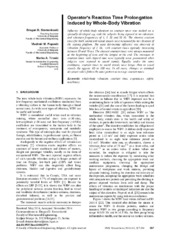Приказ основних података о документу
Produženje vremena reakcije rukovaoca uzrokovano vibracijama celog tela
Operator's reaction time prolongation induced by whole-body vibration
| dc.creator | Stamenković, Dragan | |
| dc.creator | Popović, Vladimir | |
| dc.creator | Tirović, Marko A. | |
| dc.date.accessioned | 2022-09-19T17:30:55Z | |
| dc.date.available | 2022-09-19T17:30:55Z | |
| dc.date.issued | 2014 | |
| dc.identifier.issn | 1451-2092 | |
| dc.identifier.uri | https://machinery.mas.bg.ac.rs/handle/123456789/1986 | |
| dc.description.abstract | Uticaj vibracija celog tela na vreme reakcije analiziran je uz pomoć, za ovu svrhu napravljenog, probnog stola sa mehaničkim pobudnim uređajem. Ispitanici su izlagani uslovima bez vibracija i vibracijama učestanosti 1, 5, 20 i 50 Hz. Najkraća vremena reakcije, kako na zvučne tako i na vizuelne pobude, izmerena su u uslovima bez vibracija. Najštetniji uticaj je primećen u slučaju vibracija učestanosti 5 Hz, kada se prosečna vremena reakcije uvećavaju za 50 do 70 ms. Najkraća vremena reakcije izmerena su na počecima testova, a najduža na njihovim završecima. Produženje vremena reakcije sa proticanjem vremena testa je izraženije u slučaju zvučnih pobuda. Takođe, pod istim uslovima, izmerena vremena reakcije su duža u slučaju zvučne pobude u odnosu na vizuelnu pobudu (u proseku za 60 do 100 ms). U svim slučajevima, promena vrednosti standardne devijacije pratila je obrazac sličan obrascu promene srednjih vrednosti vremena reakcije. | sr |
| dc.description.abstract | Influence of whole-body vibration on reaction times was studied on a specially developed rig, with the subjects being exposed to no vibration, and vibration frequencies of 1, 5, 20 and 50 Hz. The shortest reaction times for both, sound and visual stimuli were measured for no vibration of the seating platform. The most detrimental influence was observed at vibration frequency of 5 Hz, with reaction times typically increasing between 50 and 70 ms. The shortest reaction times were always measured at the beginning of tests and the longest at the end. The increases in reaction times with elapsed time were typically more pronounced when subjects were exposed to sound stimuli. Equally, under the same conditions, reaction times to sound stimuli were longer than to visual stimuli (by approx. 60 to 100 ms). In all cases, changes in standard deviation values follow the same pattern as average reaction times. | en |
| dc.publisher | Univerzitet u Beogradu - Mašinski fakultet, Beograd | |
| dc.relation | info:eu-repo/grantAgreement/MESTD/Technological Development (TD or TR)/35045/RS// | |
| dc.relation | info:eu-repo/grantAgreement/MESTD/Technological Development (TD or TR)/35040/RS// | |
| dc.rights | openAccess | |
| dc.rights.uri | https://creativecommons.org/licenses/by/4.0/ | |
| dc.source | FME Transactions | |
| dc.subject | whole-body vibration | en |
| dc.subject | safety | en |
| dc.subject | reaction time | en |
| dc.subject | machinery | en |
| dc.subject | ergonomics | en |
| dc.title | Produženje vremena reakcije rukovaoca uzrokovano vibracijama celog tela | sr |
| dc.title | Operator's reaction time prolongation induced by whole-body vibration | en |
| dc.type | article | |
| dc.rights.license | BY | |
| dc.citation.epage | 304 | |
| dc.citation.issue | 4 | |
| dc.citation.other | 42(4): 297-304 | |
| dc.citation.rank | M24 | |
| dc.citation.spage | 297 | |
| dc.citation.volume | 42 | |
| dc.identifier.doi | 10.5937/fmet1404297S | |
| dc.identifier.fulltext | http://machinery.mas.bg.ac.rs/bitstream/id/782/1983.pdf | |
| dc.identifier.scopus | 2-s2.0-84921859635 | |
| dc.type.version | publishedVersion |


